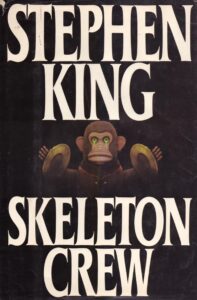Welcome back to the feature column that explores Stephen King’s books in the order they were published! (Sort of!) His third collection of short stories is his more diverse – but is it his best? WARNING: members of this crew get into spoiler territory.
Every book finds a reader in the most unexpected places. Released in 1985, between Thinner and It, this was arguably the height of Stephen King’s publishing power. It showcases King’s flexibility as a writer, delving into sci-fi and poetry for the first time.
For me, it will always be one of the books that I read during the third month of a global pandemic, and that does really strange things to one’s brain. Look it up: it’s science.
Following a wonderful introduction, one in which King calls short stories “a quick kiss in the dark from a stranger,” this hefty volume rolls out like a train of thought. Indeed, the stories span about 17 years worth of King’s creative thoughts, from his second professional sale (‘The Reaper’s Image’ from 1969) to ‘The Ballad of the Flexible Bullet’ completed in 1983. In total, there’s 19 short stories, two poems and a novella.
The latter opens the book, and is arguably the most well-known of the stories in this assortment. ‘The Mist’ was published three years earlier in the Dark Forces anthology, and has since been adapted into a film and TV series. Having read it relatively recently, I skipped over it this time because it takes up a quarter of the text! Yet it’s worth remembering that it’s a straight-up horror piece, incredibly taut and straightforwardly told. One of the handful of instances where King uses first-person perspective, the siege genre adds urgency while emphasising Lovecraftian gut-horror.
King’s fondness for Lovecraft emerges more directly in two other stories. In ‘Gramma,’ a boy left alone with a not-quite-dead grandmother is overtly tied to the Cthulhu Mythos, while the Castle Rock adjacent ‘Nona’ follows a Lovecraftian theme of rats in the walls. (Which is actually the title of one of H.P. Lovecraft’s stories, not to mention subject of King’s ‘Jerusalem’s Lot’ (1978) and ‘Graveyard Shift’ (1970) shorts).

Unlike previous shorts collections Night Shift and the four novellas of Different Seasons, this is more of a grab bag of ideas. ‘Here There Be Tygers,’ for example, is written from the perspective of a boy who believes there’s a tiger in his school bathroom. ‘The Monkey’ is King’s spin on a cursed doll tale (someone set this thing to evil!), and is an idea he continued to explore over the years. ‘Cain Rose Up,’ about a depressed and homicidal college student on a shooting spree, somehow remains in print despite King’s self-censorship of the thematically similar Rage.
For Constant Readers, things get a little more interesting with ‘Mrs. Todd’s Shortcut,’ ayuh. Along with referencing Cujo, the story of a woman who finds shortcuts in highways (like a folded map) has been largely interpreted as a reference to the todash space in the Dark Tower series as well as the travel methods seen in The Talisman. A strange creature found in the grill of her car may also have you crying out ‘Oy!’ at the inhumanity of the roadkill. (Outside of ‘The Man Who Would Not Shake Hands,’ which is set in the same club as ‘The Breathing Method,’ it’s the most undisguised intertextuality in the book). At any rate, it’s the most Kingish tale in the first half of the collection.
In fact, there might be some of the most singularly dark offerings of any King book found in SKELETON CREW. ‘Uncle Otto’s Truck’ is about the intense passion of the paranoid, as an old man stares vigilantly at an abandoned truck he is convinced is slowly moving, and his death is no less gruesome. ‘The Raft’ puts four college kids in the middle of a lake before they are devoured by a mysterious inky-black substance, a proper 80s horror story complete with a non-sequitur sex scene.
“I got to thinking about cannibalism one day…”
Then there’s the properly dark stuff. ‘Survivor Type’ is potentially one of the most gruesome stories that King has ever written, as a disgraced surgeon stranded on a desert island slowly starts devouring himself. In some notes in the backmatter, King begins that he “got to thinking about cannibalism one day…” which probably sums it up nicely. The kicker of a final line is finger licking good, y’all.
Less successful is ‘The Jaunt,’ the title of which refers to the common practice of teleportation in the future. One of King’s rare forays into straight sci-fi, it spends much of its time explaining its own premise before leaving us on a twist (it was first published in The Twilight Zone Magazine, after all) that is outrageously dumb. Yet King has a more solid sci-fi adventure with ‘Beachworld,’ a completely enveloping tale of some stranded spacemen who become enraptured by sentient sand dunes. It feels a bit like a Kōbō Abe story in some ways.
“Last night a dark man with no face crawled through nine miles of sewer to surface in my toilet…”
It was a delight and a surprise to find some poetry in this collection as well. While I’d read some of King’s verse before (such as ‘The Dark Man,’ published as a standalone illustrated volume), it was nice to turn the page and find it here. Indeed, ‘Paranoid: A Chant’ alludes to the ‘a dark man with no face’ (tying it to The Stand and The Dark Tower series) in its hypnotic ramblings of a madman. ‘For Owen’ is a more personal affair, written as a conversation with his son about sentient fruit attending a school!
There’s certainly a overall lower ‘hit rate’ in this collection that some of King’s earlier anthologies, yet we always get the sense that he was trying to stretch himself here. Two fragmentary shorts with the sub-labels ‘Milkman No. 1’ and ‘Milkman No. 2’ were from an abandoned serial killer novel. On the other hand, ‘The Wedding Gig’ is rife with fat-shaming, something we’ve seen before.
In fact, we see it again in relation to the wife of the protagonist in ‘Word Processor of the Gods.’ As the title would imply, it’s already a somewhat dated story further hamstrung by a ‘twist’ in which everybody comes off as jerkish. King being King, there’s a bit of writerly introspection as well. Likewise, ‘The Ballad of the Flexible Bullet’ has some great story-within-a-story musings on madness, and is perhaps a part confessional on how deep a writer gets into his own work.
The original title of SKELETON CREW was Night Moves, and somehow that seems more apt. This is a collection that moves in and out of those shadowy places like a thief in the night, occasionally sneaking up on you unawares. Yet for long swathes of time, I was unaware of its machinations entirely. There are stories I’ve not even mentioned here.
At other times, it grabbed me by my shirt collar and shook me out of my isolife malaise. It’s difficult to be completely objective about a book read in such strange circumstances. Yet perhaps this abstract feeling adds to the experience. As King says in an afterword, “I don’t know about you, but every time I come to the end, it’s like waking up.”
Next time, because I’ve now read a couple out of order, Inconstant Reader heads straight to 1987 and The Tommyknockers. King calls it “an awful book.” Can’t wait! While you’re here, go check out Batrock.net, where my buddy Alex Doenau is running through this Stephen King adventure with me.






